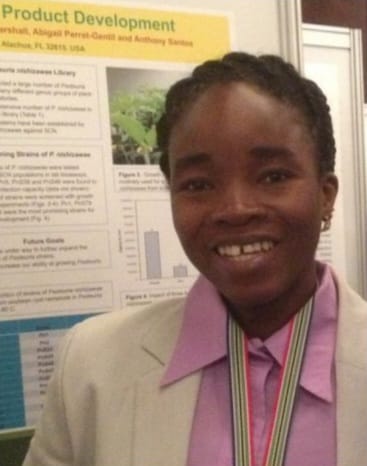Oluwatoyin Adenike Fabiyi
@unilorin.edu.ng
Lecturer, Faculty of Agriculture
Lecturer, Faculty of Agriculture
University of Ilorin
RESEARCH, TEACHING, or OTHER INTERESTS
Plant Science, Renewable Energy, Sustainability and the Environment, Spectroscopy, Toxicology
Scopus Publications
Scopus Publications
O. A. Fabiyi, T. T. Bello, A. Lateef, O. A. Abiodun, O. E. Fadeyi, E. B. Gueguim-Kana, L. S. Beukes, N. Matyumza, and G. A. Olatunji
Springer Science and Business Media LLC
Oluwatoyin Adenike Fabiyi
Walter de Gruyter GmbH
Abstract Meloidogyne incognita is a common pest of carrots grown in hot climates. Existing control methods using synthetic nematicides are associated with contamination and intoxication of plants and the production environment. Recent research trends in pest control include investigations on the use of plant materials. In the present study, Blumea aurita compost, powder, and essential oil were assessed in comparison with Furadan for mitigating the effects of M. incognita on carrot plants. The essential oil was applied at 10, 20, and 30 mg·ml−1, while the compost and powder were applied at 1.0, 2.0, and 3.0 kg·m−2. The characteristic components of B. aurita essential oil were trans-α-bergamotene (18.04%), caryophyllene epoxide (15.01%), eugenol (11.59%), carvacrol (11.02%), geraniol (10.13%), 1-octen-3-ol (7.03%), 1,8-cineole (7.02%), δ-elemene (7.01%), and α-copaene (6.20%). The reproduction of M. incognita on carrot roots and the level of M. incognita soil infestation were significantly reduced by B. aurita compost and essential oil. The effect of B. aurita compost was comparable to that of the standard nematicide – Furadan. Therefore, materials derived from B. aurita may prove to be an interesting alternative in inhibiting M. incognita populations.
Oluwatoyin Adenike Fabiyi and Gabriel Ademola Olatunji
Springer Science and Business Media LLC
Oluwatoyin Adenike Fabiyi, Olusoji Olusegun Adebisi, Sunday Olubusuyi Falore, and Abiodun Olufunmilayo Claudius-Cole
Springer Science and Business Media LLC
Oluwatoyin Adenike Fabiyi, Olusoji Olusegun Adebisi, Sunday Olubusuyi Falore, and Abiodun Olufunmilayo Claudius-Cole
Springer Science and Business Media LLC
Oluwatoyin Adenike Fabiyi and Gabriel Ademola Olatunji
Springer Science and Business Media LLC
Oluwatoyin Fabiyi, Agbaje Lateef, Evariste Bosco Gueguim-Kana, Lorika Selomi Beukes, Ntombozuko Matyumza, Tesleem Bello, and Gabriel Olatunji
Springer Science and Business Media LLC
Oluwatoyin Fabiyi, Agbaje Lateef, Evariste Bosco Gueguim-Kana, Lorika Selomi Beukes, Ntombozuko Matyumza, Tesleem Bello, and Gabriel Olatunji
Springer Science and Business Media LLC
Oluwatoyin Adenike Fabiyi and Abigail Abosede Olojede
ResearchersLinks Ltd
Tesleem Taye Bello, Abdulmujib Yusuf, Taofeek T. Adegboyega, and Oluwatoyin Adenike Fabiyi
CRC Press
Abdulmujib Gboyega Yusuf, Tesleem Taye Bello, and Oluwatoyin Adenike Fabiyi
CRC Press
Arshi Anees, Rishil Gupta, P V Phanindra, Oluwatoyin Adenike Fabiyi, Uday Kumar Thera, Tesleem Taye Bello, and Faheem Ahmad
CRC Press
Oluwatoyin Adenike Fabiyi, Rizwan Ali Ansari, Rose Rizvi, Aisha Sumbul, and Irshad Mahmood
Springer Nature Singapore
Tesleem Taye Bello and Oluwatoyin Adenike Fabiyi
Springer Nature Singapore
Tesleem Taye Bello and Oluwatoyin Adenike Fabiyi
Springer Nature Singapore
Olaolu Fadeyi, Oluwatoyin Fabiyi, Tesleem Bello, and Gabriel Olatunji
ResearchersLinks Ltd
O.A. Fabiyi, T.T. Bello, G. Liébanas, I. Clavero-Camacho, C. Cantalapiedra-Navarrete, A. Archidona-Yuste, J.E. Palomares-Rius, D.J. Hunt, and P. Castillo
Cambridge University Press (CUP)
Abstract Parasitic nematodes of millipedes from Nigeria are molecularly characterized for the first time. During nematode surveys on live giant African millipedes from several localities in Nigeria, 4 species of rhigonematids were identified by application of integrative taxonomical approaches (morpho-anatomy and molecular markers), including Brumptaemilius sp., Gilsonema gabonensis, Obainia pachnephorus, and Rhigonema disparovis. The results of morphometric and molecular analyses of D2-D3 28S, ITS, partial 18S rRNA, and cytochrome oxidase c subunit 1 (COI) gene sequences further characterized the rhigonematid species, and clearly separated them from other related species. Phylogenetic relationships based on 28S and 18S rRNA genes suggest that genera within Ransomnematoidea (Ransomnema, Heth, Carnoya, Brumptaemilius, Cattiena, Insulanema, Gilsonema) and Rhigonematoidea (Rhigonema, Obainia, Xystrognathus, Trachyglossoides, Ichthyocephaloides) clustered rather closer than could be expected in view of their morphological differences. Phylogenetic relationships based on ITS and COI are congruent with those of other ribosomal genes; however, they are not conclusive due to the scarcity of available sequences of these genes for these genera in NCBI.
O. A. Fabiyi, O. O. Adebisi, S. O Falore, T. T. Bello, and G. A. Olatunji
Springer Science and Business Media LLC
Nusirat Aderinsola Sadiku, Oluwatoyin Adenike Fabiyi, and Tesleem Taye Bello
ResearchersLinks Ltd
Oluwatoyin Adenike Fabiyi and Tesleem Taye Bello
Springer Nature Singapore
Oluwatoyin Adenike Fabiyi
CRC Press
Oluwatoyin Adenike Fabiyi
CRC Press

